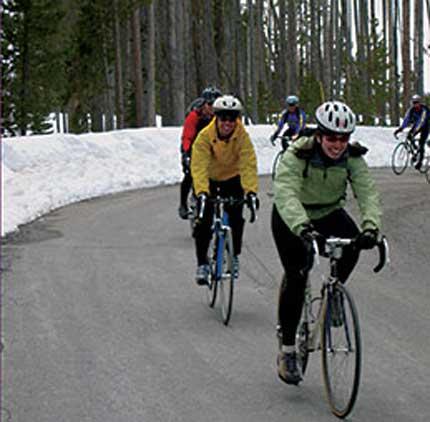Crews in Yellowstone National Park are clearing roads of snow and ice to reopen the routes to vehicles, but that work is expected to take a month or more. In the meantime, hardy bicyclists have an opportunity to experience a ride on some of those roads without competition from other visitor traffic.
Bicyclists can now ride between West Yellowstone, Madison, Norris, and Mammoth Hot Springs. These trips can be a fine opportunity for experienced—and well-prepared—cyclists, but the park cautions that they aren't for everyone:
Cycling in Yellowstone National Park during this time of year is not for the faint of heart. The cleared section of the road may be narrow and covered with a layer of snow and ice, and pullouts may remain filled with snow. The road in the active construction zone between Norris and Madison through Gibbon Canyon is unpaved, rough, and may be very muddy.
Cyclists should also expect to encounter snowplows or other vehicles operated by park employees or construction workers traveling in conjunction with park operations.
Weather in Yellowstone is always a factor to consider, and spring is no exception.
The weather is unpredictable, and severe winter conditions can be encountered at any time. There are no services open in the interior of the park and riders should be prepared to take care of all their own needs. Cyclists are urged to call 307-344-2109 from 8:00 a.m. to 4:30 p.m. on weekdays for updated road access information, or call 307-344-2113 for 24-hour weather information before traveling to the area.
The park has some additional tips and requests: Cyclists are asked to ride single file, encouraged to carry bear spray, and should be prepared to turn around and backtrack when encountering wildlife on the road.
A "Spring Bicycling" page on the park's website includes additional important details that should be reviewed prior to a trip, including a map of the roads available for cyclists, additional rules and safety tips, and some very helpful information. For example, it would be very useful to know that "Prevailing winds blow from the west making the ride toward Madison far easier and more comfortable than the return trip."
Snow removal efforts may also allow for a brief period of bicycle-only access into the park sometime in May from the South Entrance to West Thumb, and from the East Entrance toward Sylvan Pass. There is no seasonal bicycle-only access to Old Faithful or Canyon.
The road from the North Entrance at Gardiner, Montana, to Cooke City, Montana, at the park's Northeast Entrance, is open all year to cyclists and automobiles, weather permitting. Updated Yellowstone National Park road information is available 24 hours a day by calling 307-344-2117.
The spring cycling season is a short one. Baring unexpected delays due to weather or other factors, some interior park roads are scheduled to begin opening to motorized vehicles on Friday morning, April 16. Other roads don’t open to automobile travel until Memorial Day weekend. The "current conditions and updates" page on the park website can help keep you posted on the latest news for travelers to the park.




Add comment